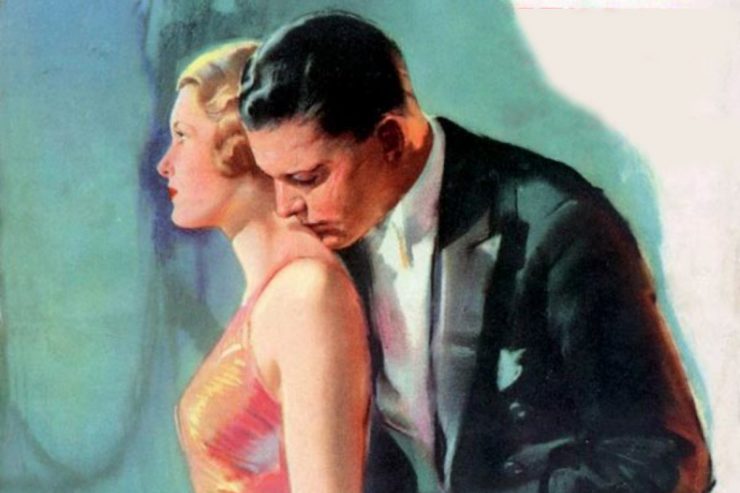Pulp magazines have influenced writers, artists, film directors, software developers, and countless others over the years. Our “PulpFest Historical” articles focus on the rough-paper writers, editors, publishers, and artists who have inspired and continue to inspire the creators of the world’s popular culture.
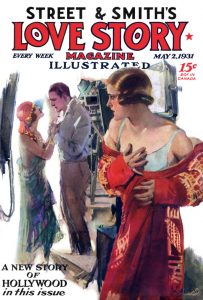 Street & Smith’s LOVE STORY MAGAZINE is credited with being the most popular of all pulp fiction magazines and the pulp that launched the entire romance fiction magazine industry. But it’s anyone’s guess if Ormond Smith, part owner of Street & Smith, and Henry Ralston, his chief idea man, knew they had a hit on their hands when they launched the pulp in the spring of 1921.
Street & Smith’s LOVE STORY MAGAZINE is credited with being the most popular of all pulp fiction magazines and the pulp that launched the entire romance fiction magazine industry. But it’s anyone’s guess if Ormond Smith, part owner of Street & Smith, and Henry Ralston, his chief idea man, knew they had a hit on their hands when they launched the pulp in the spring of 1921.
For such a popular publication, not a lot has been chronicled about the early years of LOVE STORY. However, one thing is certain: the history of its beginnings is a mix of drama, sentiment, and mystery … much like the stories the magazine featured between its covers.
For more than a decade, Ormond Smith was looking for a formula that would work with women. The company’s dime novel and story paper romances had done very well over the years. Smith wanted to recreate that audience.
Street & Smith’s first attempts to appeal to twentieth-century women didn’t take off. Launched in 1913, WOMEN’S STORIES lasted only a year before its name was changed to LIVE STORIES. Two years later, it was sold. SMITH’S MAGAZINE — which the company had debuted with high hopes in 1905 — was going nowhere. It would be canceled in early 1922.
Undoubtedly, there was some urgency for Street & Smith to produce something. Bernarr McFadden’s TRUE STORY — the first confession magazine — was introduced in 1919. With a circulation of almost two million copies per month by 1922, the success of TRUE STORY strongly demonstrated the power of the woman consumer. It may also have made Ormond Smith realize that if he didn’t move soon, the market would move on without him.
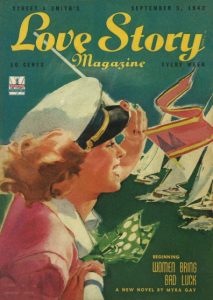 The established story of how the company came up with the concept for LOVE STORY is something of a puzzle. According to legend, the associate editor for the company’s PEOPLE’S FAVORITE MAGAZINE, Amita Fairgrieve, was given a stack of old Street & Smith dime novels and story papers. She was told to come up with a concept for a women’s magazine. Holed up in an office, Fairgrieve studied the old periodicals and, after six months, emerged with the idea for LOVE STORY MAGAZINE. For her efforts, she was named the pulp’s first editor.
The established story of how the company came up with the concept for LOVE STORY is something of a puzzle. According to legend, the associate editor for the company’s PEOPLE’S FAVORITE MAGAZINE, Amita Fairgrieve, was given a stack of old Street & Smith dime novels and story papers. She was told to come up with a concept for a women’s magazine. Holed up in an office, Fairgrieve studied the old periodicals and, after six months, emerged with the idea for LOVE STORY MAGAZINE. For her efforts, she was named the pulp’s first editor.
So goes the tale in Street & Smith’s corporate history, Quentin Reynolds’ THE FICTION FACTORY. But knowing how much the company loved a good sentimental yarn, this long-standing legend could simply be a story. It certainly shouldn’t have taken six months to come up with the LOVE STORY concept. Fairgrieve might have been holed up in an office, but it was probably as a manager-in-training, assigned to get up to speed with the kind of stories that the company wanted for its new magazine.
The day that the first issue of LOVE STORY appeared is in question too. Dated May 1921, there are different accounts as to when the issue was released.
In her college alumnae newsletter from November 1921, Amita Fairgrieve commented that the first issue appeared on July 25. To make the historical account even foggier, a 1942 issue of LOVE STORY declares that the magazine debuted on April 20, 1921. The earlier date is more in line with the first issue’s cover date.
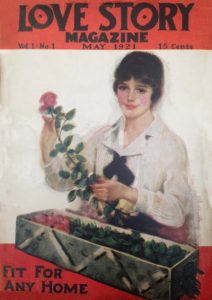 The feature story in the magazine’s first issue is also a classic Street & Smith concoction. It’s credited to the byline of Bertha M. Clay, a longtime house name. The story, “A Final Temptation,” had originally been published under the author’s real name — Charlotte M. Brame — in an 1883 British magazine. Brame’s story serves as a perfect example of what Street & Smith produced during its early years. It was a reprint that originally appeared in another company’s publication, written by an author who had been dead for 37 years. Additionally, it was published in LOVE STORY under a pseudonym used by an untold number of writers, including Frederick V. Dey and John R. Coryell.
The feature story in the magazine’s first issue is also a classic Street & Smith concoction. It’s credited to the byline of Bertha M. Clay, a longtime house name. The story, “A Final Temptation,” had originally been published under the author’s real name — Charlotte M. Brame — in an 1883 British magazine. Brame’s story serves as a perfect example of what Street & Smith produced during its early years. It was a reprint that originally appeared in another company’s publication, written by an author who had been dead for 37 years. Additionally, it was published in LOVE STORY under a pseudonym used by an untold number of writers, including Frederick V. Dey and John R. Coryell.
The first LOVE STORY cover — showing a rosy-cheeked brunette blissfully picking out a long-stemmed rose from a box of flowers — proclaimed that the magazine was “Fit for Any Home.” The stories inside the issue were created following the traditions of the company’s nineteenth-century roots. They were dramatic but respectable romance stories featuring orphaned women who needed to be rescued. Subsequent issues followed suit.
The magazine was a success from the beginning. With its second issue, LOVE STORY declared that, due to its overwhelming reception, the magazine would immediately become a semi-monthly publication. For the next year, it faithfully appeared each month with the cover dates of the 10th and the 25th. In September 1922, the publishers again responded to demand and changed LOVE STORY to a weekly. It would retain that schedule for the next twenty-one years.
Perhaps because of confusion among buyers over TRUE STORY and LOVE STORY, a full-page ad was run in an early issue that clarifies exactly what kind of content was carried in LOVE STORY.
LOVE STORY is not just another of those sex-problem magazines, which have done incalculable harm.
LOVE STORY is clean at heart, and its stories are written around the love of the one man for the one woman.
Civilization has been built upon this sort of love — all the great accomplishments of mankind have been inspired by good women who were greatly beloved.
LOVE STORY MAGAZINE will take a place in your life that no other magazine can occupy, because LOVE STORY has an irresistibly human appeal.
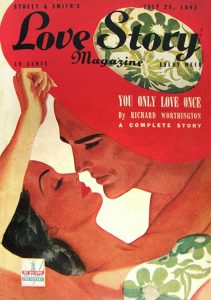 The magazine’s circulation would continue to grow over the next seven years. The company would tinker with its formula and cover styles, including using colorized cover photos. They would also copy an idea from TRUE STORY, announcing on the cover that the interior illustrations were “by direct photos from Living Models.” The tag line, “Tell Somebody Else How Good It Is,” was added later.
The magazine’s circulation would continue to grow over the next seven years. The company would tinker with its formula and cover styles, including using colorized cover photos. They would also copy an idea from TRUE STORY, announcing on the cover that the interior illustrations were “by direct photos from Living Models.” The tag line, “Tell Somebody Else How Good It Is,” was added later.
Regardless of the cover hype, the story types inside — loaded with Victorian sentiment and featuring heroines stuck in the nineteenth century — would remain the same throughout its formative years. It would take thirty-year-old Daisy Bacon assuming the position of editor in 1928 to usher in a new look and theme for the magazine. Under Bacon’s leadership, the magazine would begin to focus on the “modern girl” and offer clean, crisp narratives and realistic settings. With that change, LOVE STORY MAGAZINE headed to the stratosphere!
At PulpFest 2021, we’ll celebrate the centennial of LOVE STORY MAGAZINE by looking at the magazine and the genre it inspired, and commemorate some of the top women editors of the pulp industry, including the talented Daisy Bacon. To learn more about Bacon’s years as editor of LOVE STORY, we urge you to pick up a copy of Laurie Powers’ QUEEN OF THE PULPS: THE REIGN OF DAISY BACON AND LOVE STORY MAGAZINE, published by McFarland Books in 2019.
Introduced with its May 1921 issue — with cover art by an unknown artist — LOVE STORY MAGAZINE would become the best-selling pulp of all time and give birth to a host of imitators. During the early 1930s, LOVE STORY’s circulation hit 600,000, a record that would never be broken by any other pulp magazine.
Without a doubt, Modest Stein was the LOVE STORY artist. He contributed hundreds of covers — including the May 2, 1931 number — to the Street & Smith pulp magazine.
As the LOVE STORY woman evolved, so did Stein’s painting style. His earlier work is marked by detail and realism, while his covers of the early 1940s seem soft and more fluid. Pictured above is his cover art for the September 5, 1942 number, one of his last covers for the magazine. Beginning in late 1942, LOVE STORY increasingly turned to photographic covers until painted covers became a thing of the past.
Besides Modest Stein, other artists who contributed cover paintings to LOVE STORY MAGAZINE included Seymour Ball, Emery Clark, Duncan Coburn, William Macrae Gillies, Thelma Gooch, John Newton Howitt, William Luberoff, P. J. Monahan, Zoe Mozert, H. Leavitt Purdy, Joe Richards, Hubert Rogers, Barbara Schwinn, Marland Stone, William Timmins, Ski Weld, and most notably Dan Osher and J. Clark Work. The July 25, 1942 LOVE STORY MAGAZINE is a fine example of Work’s cover art.
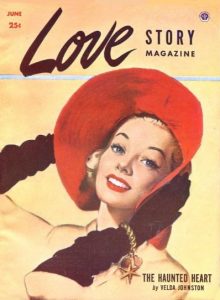 Running for 1158 issues, the last Street & Smith number of LOVE STORY MAGAZINE was dated February 1947. It would be revived in 1952 by Popular Publications and run for an additional fourteen issues. Popular’s first issue — dated June 1952 — featured cover art by Diana Stevens. Her work appeared regularly on Popular Publications titles during its later years in the pulp industry.
Running for 1158 issues, the last Street & Smith number of LOVE STORY MAGAZINE was dated February 1947. It would be revived in 1952 by Popular Publications and run for an additional fourteen issues. Popular’s first issue — dated June 1952 — featured cover art by Diana Stevens. Her work appeared regularly on Popular Publications titles during its later years in the pulp industry.
We hope you’ll join PulpFest 2021 from August 19 – 22 for “Love in the Shadows,” part of our celebration of women and the pulp industry at the DoubleTree by Hilton Hotel Pittsburgh – Cranberry in Mars, PA.

